NIGHTSHADE: Post‑Exploitation Tradecraft for Cisco Infrastructure
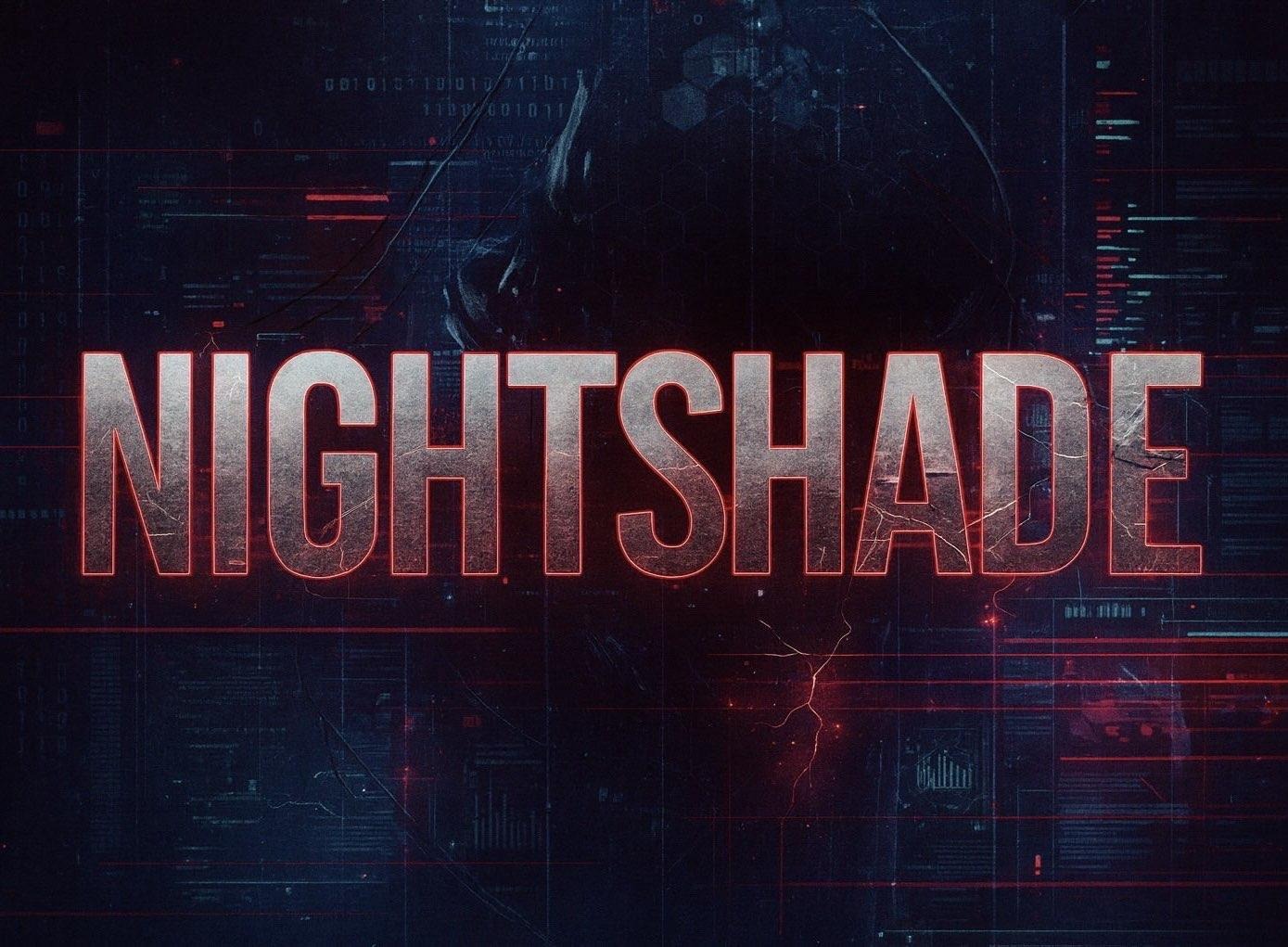
Cisco's September advisory cycle surfaced an SNMP stack overflow in IOS and IOS XE that changes the initial‑access calculus on edge devices. The issue, published as CVE‑2025‑20352, enables device reload by any party with low‑privilege SNMP access and, when paired with administrative credentials, remote code execution as root on IOS XE.
The scope is broad; external measurements suggest internet exposure in the millions, and exploitation has been observed in production networks ( reporting; see also Cisco's bundled publication and CISA's ED‑25‑03).
Initial code execution on a router, firewall, or VPN concentrator is not an end state. Operators who only trigger a crash or run a one‑shot command achieve bypass; they do not obtain durable control, telemetry, or traffic shaping. NIGHTSHADE, released as an IRIS C2 module in v1.9, was built specifically for that second phase. It translates a transient exploit—whether a historical ASA bug on a pre‑ASLR image or a modern IOS XE path—into an implant that survives process churn, exposes fine‑grained memory and traffic controls, and integrates with the rest of IRIS for command, auditing, and rollback.
Architecture
NIGHTSHADE's loader chain is designed for constrained, heterogeneous targets. Entry is deliberately small and tolerant of partial overwrites. The first stage validates available buffer space, then pivots the stack pointer to an attacker-controlled region. Each architecture maintains proper alignment for SIMD operations and system call conventions while preserving the original stack pointer for potential restoration.
The ASLR bypass stage resolves runtime addresses through process introspection. The technique parses memory mappings to identify library bases, heap regions, and stack locations. This approach works across IOS XE's Linux-based userland and classic IOS's monolithic memory model. The resolved addresses enable position-independent code execution without hardcoded offsets.
Memory allocation uses architecture-appropriate system calls to create executable space. The framework allocates read-write memory, decrypts the payload using efficient stream ciphers, then transitions to executable permissions. On architectures with separate instruction and data caches, proper cache synchronization ensures reliable execution.
The decryption layer supports both legacy stream ciphers for older devices and modern authenticated encryption for current deployments. Algorithm selection depends on target performance characteristics and security requirements. The framework implements constant-time operations where possible to resist timing-based side channels.
Process injection adapts to available platform capabilities. When process tracing is available, the framework can inject code into running processes. When dynamic loading is supported, it creates minimal shared objects that execute on load. For locked-down environments, it uses anonymous memory execution to avoid filesystem artifacts. Target selection focuses on stable, long-lived system processes that provide cover for persistent operation.
Implant
For long‑lived operations the framework deploys a compact userland implant that embeds a lightweight Lua interpreter. The interpreter is statically linked with custom bindings for direct syscall invocation, bypassing standard library wrappers that might be monitored. This allows scripts to perform low-level operations across x86_64, ARM64, and MIPS64 architectures without depending on potentially hooked functions.
The implant implements multiple anti-analysis and anti-debugging techniques. It detects active debugging through process state inspection, identifies virtualized environments through hardware fingerprinting, and uses timing-based checks to identify analysis tools. When analysis is detected, the implant can adapt its behavior based on configurable policies.
Communication uses encrypted channels with certificate validation to prevent interception. The protocol implements adaptive beaconing with jitter to avoid pattern detection. For environments with restricted outbound connectivity, the implant supports multiple transport options including DNS tunneling and domain fronting techniques.
Interface Integration
NIGHTSHADE's capabilities are exposed through IRIS C2's interface. The Exploits tab shows available vulnerability modules, including entries for CVE-2025-20352 and other Cisco-specific issues:
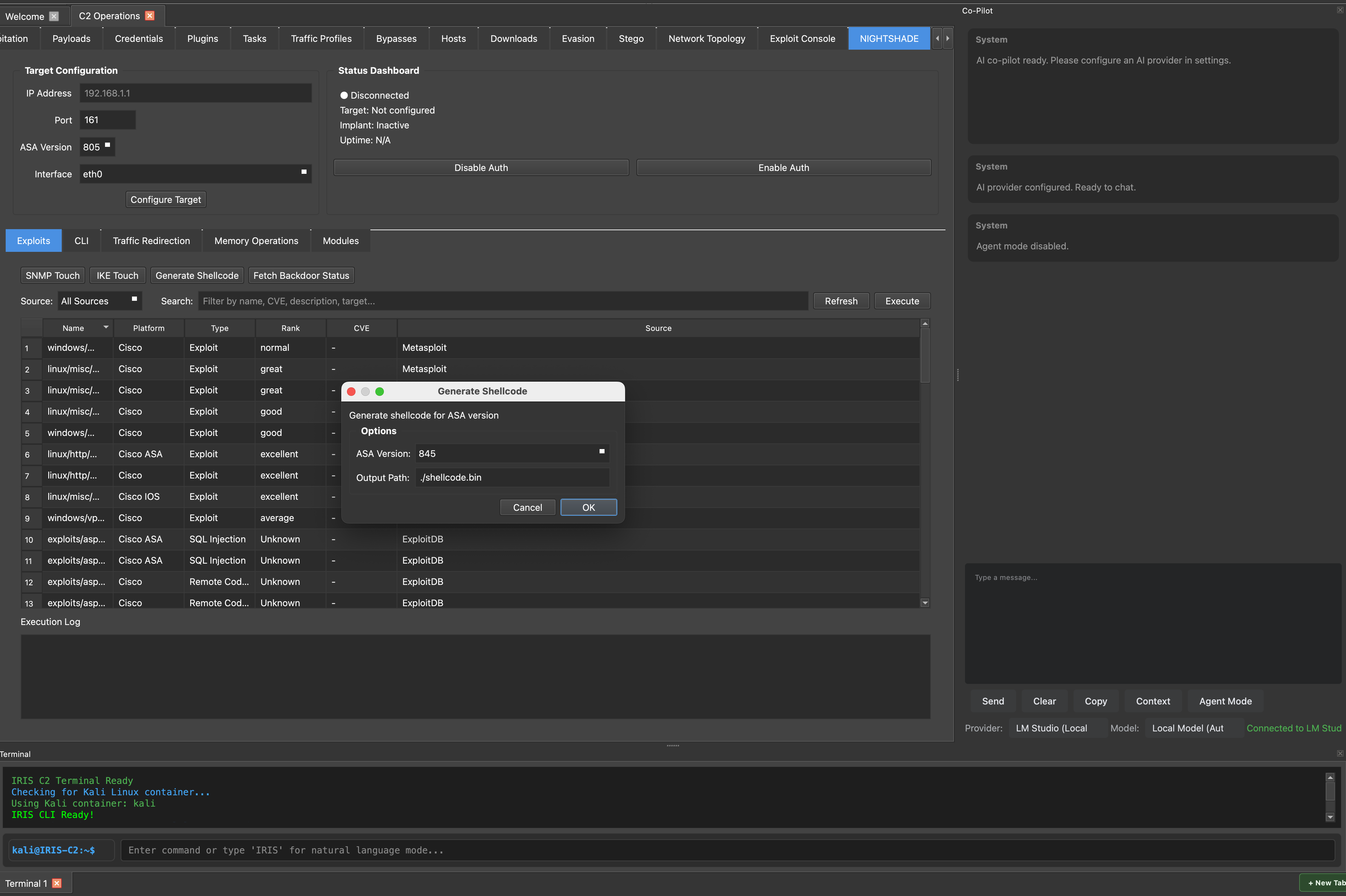
The NIGHTSHADE interface displays exploit metadata including platform compatibility, CVE identifiers, risk ratings, and source attribution. The Generate Shellcode dialog shows options for ASA version targeting and payload customization.
Traffic Redirection
The Traffic Redirection interface enables fine-grained control over network flows:
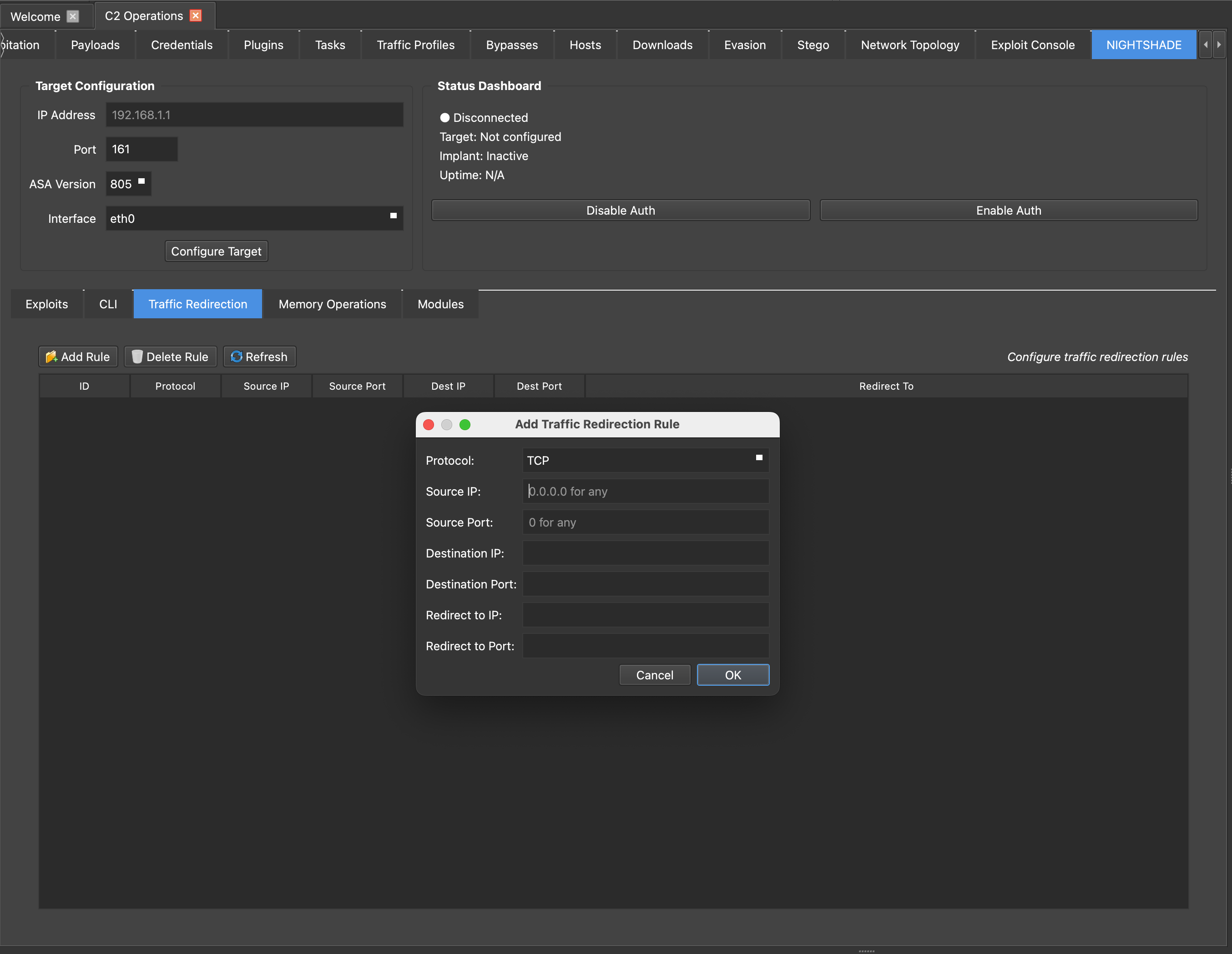
The Traffic Redirection interface shows the "Add Traffic Redirection Rule" dialog with fields for configuring protocol (TCP/UDP), source IP and port, destination IP and port, and redirect targets. This enables precise control over network flow manipulation within compromised Cisco infrastructure.
Memory Operations
Direct memory access is provided through the Memory Operations tab:
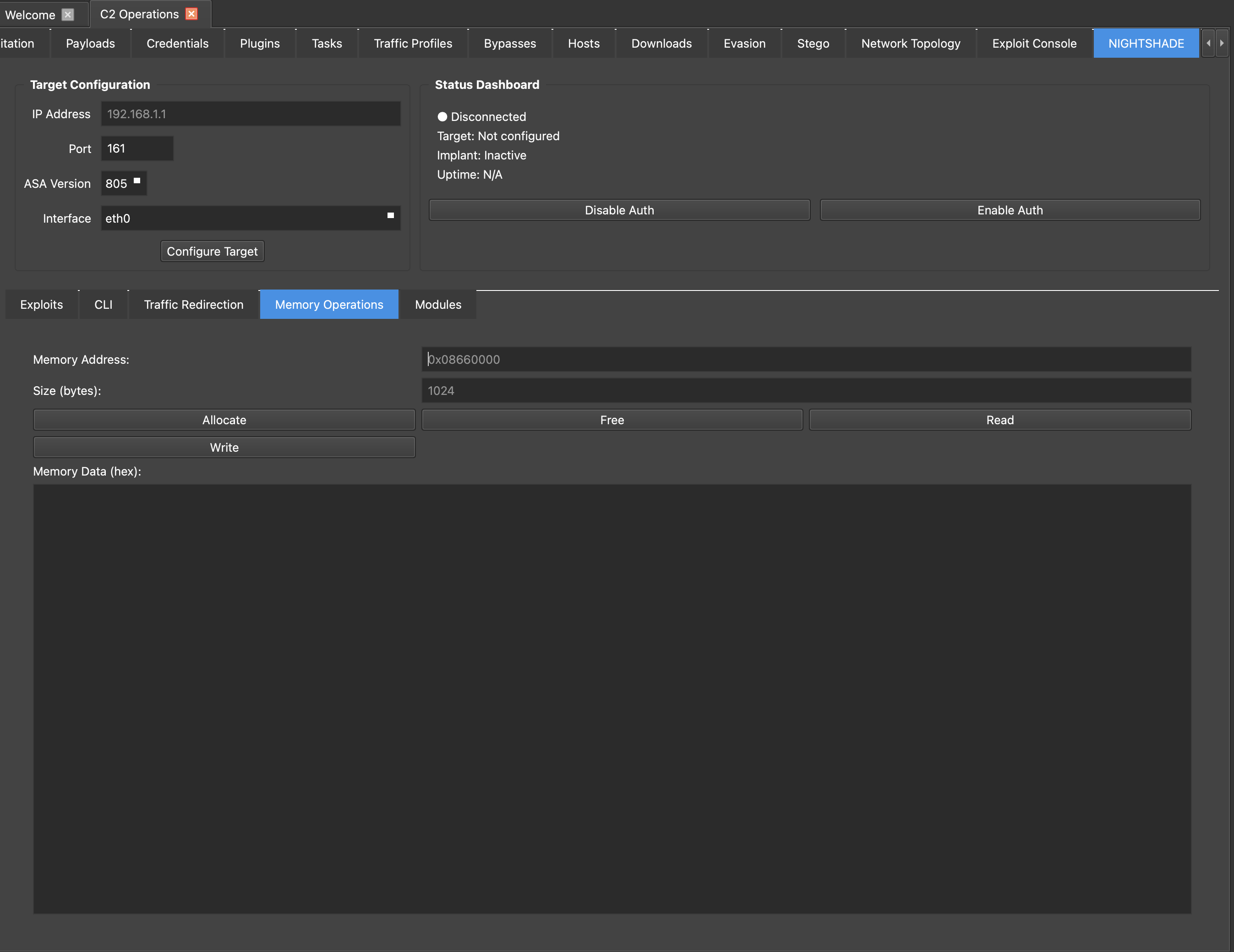
The Memory Operations interface displays direct memory access controls with a specific memory address (0x08660000), size allocation (1024 bytes), and action buttons for Allocate, Free, Read, and Write operations. The hex data display area below allows viewing and editing raw memory contents for precise control over target processes.
Post-Exploitation Modules
NIGHTSHADE's extensibility is demonstrated through the custom module interface:
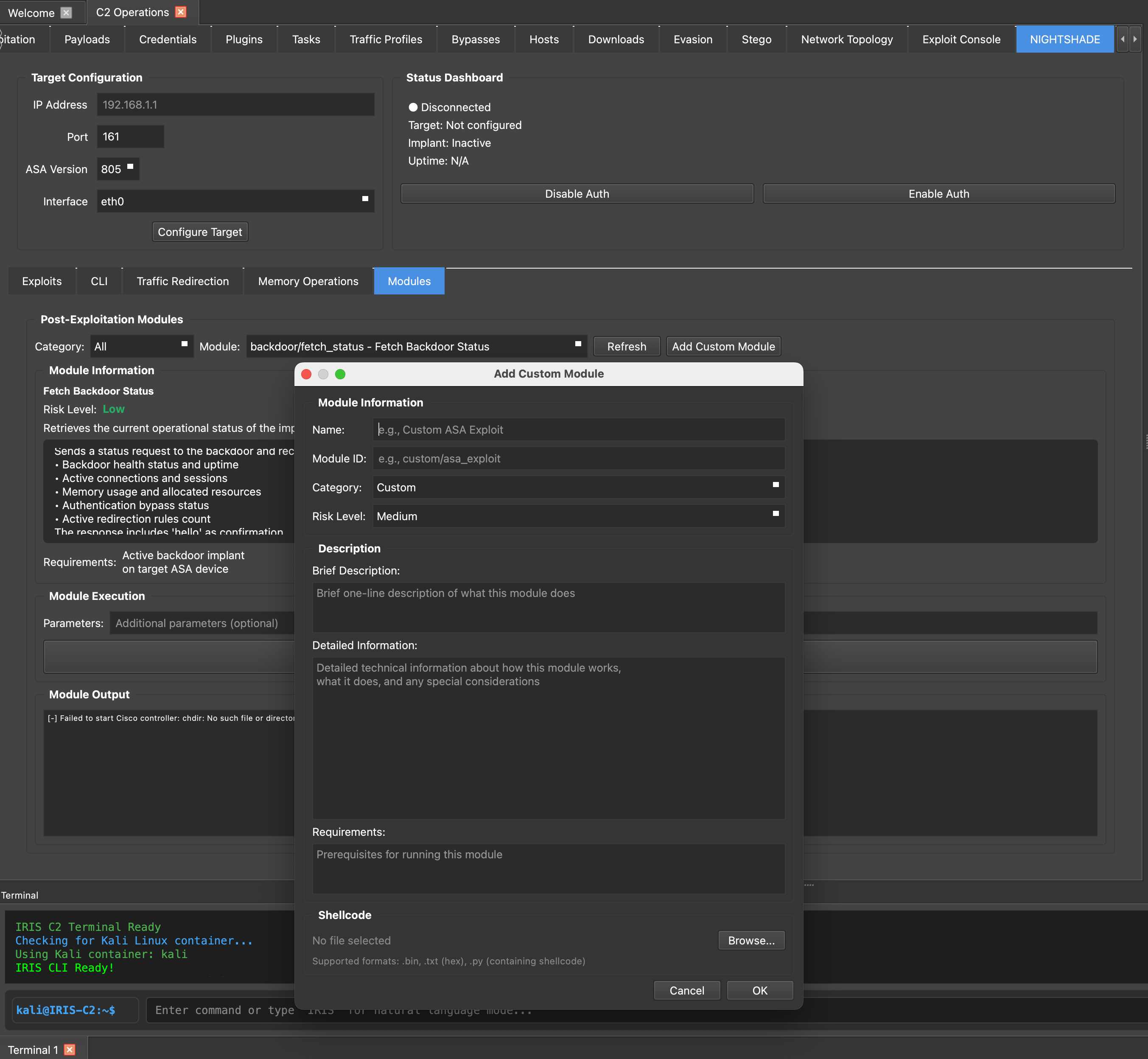
The Modules interface displays the "Add Custom Module" dialog with comprehensive configuration options including module information (name, ID, category, risk level), detailed descriptions, system requirements, and shellcode upload capabilities. The left panel shows details for the "Fetch Backdoor Status" module with its operational parameters and execution requirements.
Payload Generation
For standalone operations, NIGHTSHADE can generate architecture-specific payloads:
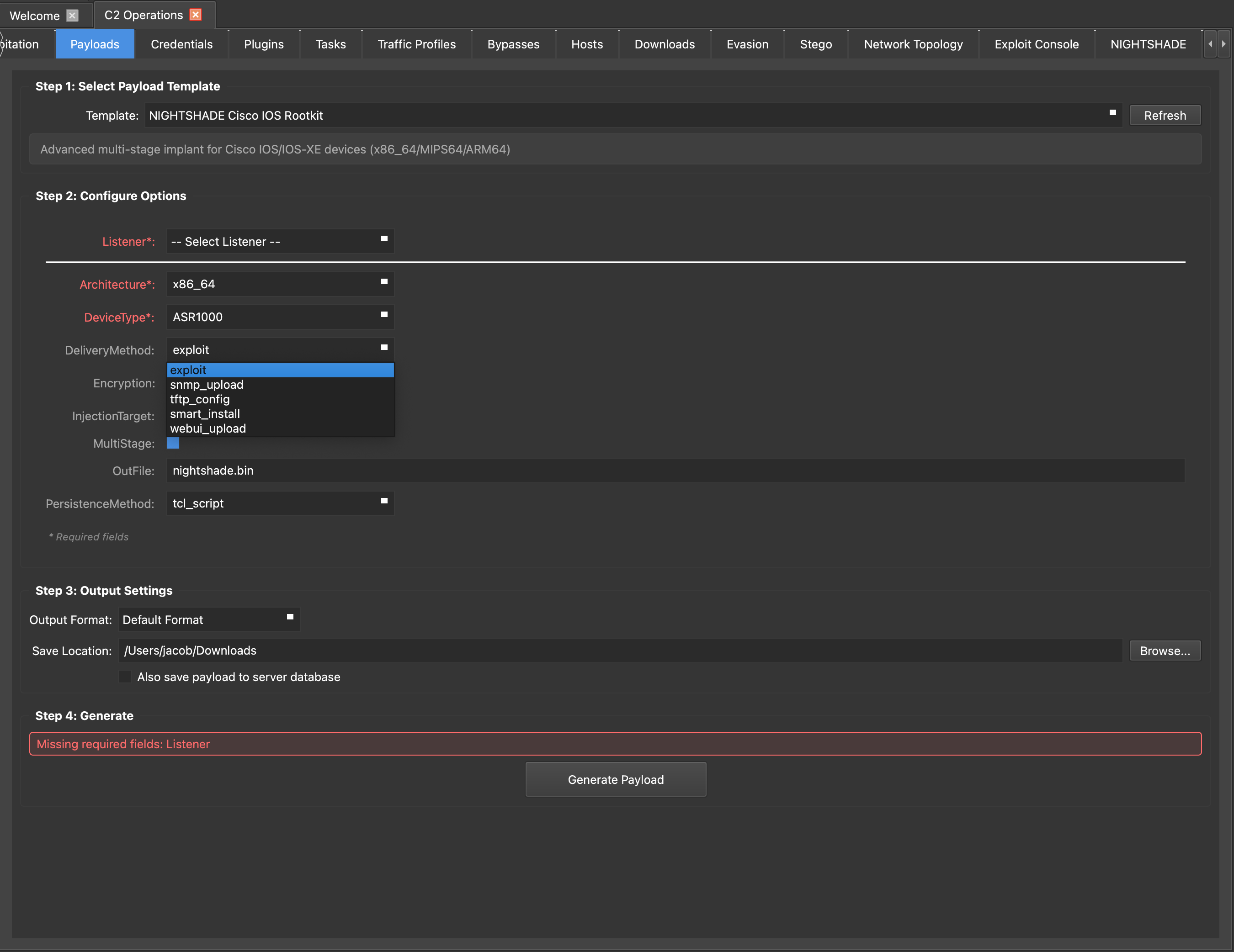
The Payload Generation interface displays a comprehensive 4-step wizard for creating NIGHTSHADE implants. Step 1 shows the selected "NIGHTSHADE Cisco IOS Rootkit" template for multi-stage implants. Step 2 reveals detailed configuration options including listener selection, architecture (x86_64), device type (ASR1000), delivery method, encryption options, and persistence methods. The interface shows a validation warning for missing required fields before payload generation.
Exploitation and Integration
NIGHTSHADE integrates with IRIS's Exploit Console, which aggregates vulnerability modules from multiple sources and allows operators to import custom exploits. For CVE-2025-20352, the framework implements the SNMP vulnerability that affects the authentication framework MIB handler, enabling stack-based exploitation. On IOS XE devices where administrative credentials are available, this provides a path to elevated code execution.
The console performs target fingerprinting through SNMP queries to determine device type and version, then selects appropriate exploitation techniques. Shellcode generation adapts to the target architecture and firmware version, with options for standalone payloads or integration with NIGHTSHADE's staging framework.
The post-exploitation transition is seamless. Once initial access is achieved, NIGHTSHADE's loader chain handles environment setup, memory allocation, and implant deployment. The console provides status updates throughout the exploitation process, from initial contact through persistent implant establishment.
Legacy Support
Many production networks continue to operate older ASA devices that predate modern exploit mitigations. For these systems, NIGHTSHADE includes specialized techniques developed through extensive research into Cisco's legacy architectures. These older platforms have different memory layouts and lack the address randomization of current releases.
The legacy path targets Cisco's core routing and inspection processes through careful manipulation of internal structures. By intercepting key dispatch mechanisms, the framework can insert hooks that provide authentication bypass, traffic redirection, and memory access capabilities while maintaining normal device operation.
Flow interception on legacy devices uses a different approach than modern platforms, hooking directly into the packet processing pipeline rather than using operating system facilities. This allows the same traffic manipulation capabilities through platform-specific implementation.
Forensic Countermeasures
NIGHTSHADE implements anti-forensic measures designed to minimize detection and attribution. The framework removes traces from standard logging locations while preserving file metadata to avoid obvious tampering indicators. Command history and authentication logs receive particular attention, with modifications designed to blend with normal system behavior.
Memory forensics resistance employs multiple overlapping techniques. Sensitive data is cleared after use, memory pages containing critical code are protected from swapping, and cleanup routines execute on termination. The implant configures process attributes to prevent core dump generation and resists common memory acquisition tools.
Against network forensics, the framework implements traffic patterns that mimic legitimate administrative protocols. Communication blends with normal device management traffic, using standard ports and protocols where possible. Timing patterns avoid the regular intervals that often reveal automated malware.
File system artifacts are minimized through in-memory operation where possible. When persistent storage is required, the framework uses techniques that avoid creating new files or modifying timestamps in ways that would trigger forensic timelines. Configuration data is stored using methods that resist casual discovery while remaining accessible to the implant.
Operational Notes and Defensive Context
Devices compromised via SNMP issues are frequently still managed via SNMP, and the same control planes that give observability to administrators can also be used to detect abuse. Cisco's advisory outlines a mitigation that constrains specific object IDs through snmp-server view and applies that view to communities and v3 groups; the configuration change reduces attack surface without disabling management entirely ( advisory).
From our side we encourage operators doing authorized testing to measure the before/after effect of those views, to segment device management away from user traffic, and to treat firmware updates as a security boundary; Cisco documents fixed releases in the Event Response, and CISA's directive sets response timelines for federal environments.
Availability
NIGHTSHADE is part of IRIS C2 and is enabled only for select, highly vetted customers. Export restrictions apply and access requires contractual authorization for lawful testing or defensive research. If your team operates networks that include IOS, IOS XE, or ASA and you need to assess exposure and response at the post‑exploitation layer, contact us to discuss eligibility.
This post references public reporting and vendor guidance for completeness: Cisco's CVE‑2025‑20352 advisory, Cisco's September bundled publication, CISA ED‑25‑03, and independent coverage cited above. The software described here is designed for authorized use only.
Ready to enhance your post-exploitation capabilities? NIGHTSHADE is available as part of IRIS C2's comprehensive framework for authorized security testing. Learn more about IRIS C2's advanced capabilities by reaching out to info@IRISC2.com.